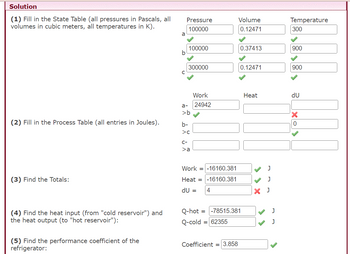Goal Solve for the performance coefficient of a refrigerator using a five-step process the includes: 1. Making a state table. 2. Making a process table. 3. Calculating the totals for Work, Heat, and Internal-Energy-Change. 4. Identifying the heat input (cold reservoir) and output (hot reservoir). 5. Calculating the performance coefficient of the refrigerator. Problem Shown in the figure to the right is a cyclic process undergone by a refrigerator. Your refrigerator shall use 5.0 moles of helium gas (monatomic). During the process a->b, the volume increases by a factor of 3.0.
Goal Solve for the performance coefficient of a refrigerator using a five-step process the includes: 1. Making a state table. 2. Making a process table. 3. Calculating the totals for Work, Heat, and Internal-Energy-Change. 4. Identifying the heat input (cold reservoir) and output (hot reservoir). 5. Calculating the performance coefficient of the refrigerator. Problem Shown in the figure to the right is a cyclic process undergone by a refrigerator. Your refrigerator shall use 5.0 moles of helium gas (monatomic). During the process a->b, the volume increases by a factor of 3.0.
Elements Of Electromagnetics
7th Edition
ISBN:9780190698614
Author:Sadiku, Matthew N. O.
Publisher:Sadiku, Matthew N. O.
ChapterMA: Math Assessment
Section: Chapter Questions
Problem 1.1MA
Related questions
Question
Goal Solve for the performance coefficient of a refrigerator using a five-step process the includes:
1. Making a state table.
2. Making a process table.
3. Calculating the totals for Work, Heat, and Internal-Energy-Change.
4. Identifying the heat input (cold reservoir) and output (hot reservoir).
5. Calculating the performance coefficient of the refrigerator.
Problem Shown in the figure to the right is a cyclic process undergone by a refrigerator. Your refrigerator shall use 5.0 moles of helium gas (monatomic). During the process a->b, the volume increases by a factor of 3.0.
Solution-
| (1) Fill in the State Table (all pressures in Pascals, all volumes in cubic meters, all temperatures in K). |
|
||||||||||||||||
| (2) Fill in the Process Table (all entries in Joules). |
|
||||||||||||||||
| (3) Find the Totals: |
|
||||||||||||||||
| (4) Find the heat input (from "cold reservoir") and the heat output (to "hot reservoir"): |
|
||||||||||||||||
| (5) Find the performance coefficient of the refrigerator: |
|

Transcribed Image Text:Solution
(1) Fill in the State Table (all pressures in Pascals, all
volumes in cubic meters, all temperatures in K).
(2) Fill in the Process Table (all entries in Joules).
(3) Find the Totals:
(4) Find the heat input (from "cold reservoir") and
the heat output (to "hot reservoir"):
(5) Find the performance coefficient of the
refrigerator:
a
b
с
Pressure
a->b
b->c
c->a
Work
Work =
Heat =
dU =
Q-hot
Q-cold
=
=
Coefficient =
Volume
Heat
J
J
J
J
Temperature
du

Transcribed Image Text:Complete Analysis of a Refrigerator
Goal Solve for the performance coefficient of a refrigerator using a five-step
process the includes:
1. Making a state table.
2. Making a process table.
3. Calculating the totals for Work, Heat, and Internal-Energy-Change.
4. Identifying the heat input (cold reservoir) and output (hot reservoir).
5. Calculating the performance coefficient of the refrigerator.
Problem Shown in the figure to the right is a cyclic process undergone by a
refrigerator. Your refrigerator shall use 5.0 moles of helium gas
(monatomic). During the process a->b, the volume increases by a factor of
3.0.
P
T₂
= 300 K
isothermal
P₁ = 100,000 Pa
Refrigerator Cycle
b
Expert Solution
This question has been solved!
Explore an expertly crafted, step-by-step solution for a thorough understanding of key concepts.
This is a popular solution!
Trending now
This is a popular solution!
Step by step
Solved in 5 steps

Follow-up Questions
Read through expert solutions to related follow-up questions below.
Follow-up Question
Can I get the clear format solution for part 2 table (work, heat, du)
and du for part 3 table

Solution
Knowledge Booster
Learn more about
Need a deep-dive on the concept behind this application? Look no further. Learn more about this topic, mechanical-engineering and related others by exploring similar questions and additional content below.Recommended textbooks for you

Elements Of Electromagnetics
Mechanical Engineering
ISBN:
9780190698614
Author:
Sadiku, Matthew N. O.
Publisher:
Oxford University Press

Mechanics of Materials (10th Edition)
Mechanical Engineering
ISBN:
9780134319650
Author:
Russell C. Hibbeler
Publisher:
PEARSON

Thermodynamics: An Engineering Approach
Mechanical Engineering
ISBN:
9781259822674
Author:
Yunus A. Cengel Dr., Michael A. Boles
Publisher:
McGraw-Hill Education

Elements Of Electromagnetics
Mechanical Engineering
ISBN:
9780190698614
Author:
Sadiku, Matthew N. O.
Publisher:
Oxford University Press

Mechanics of Materials (10th Edition)
Mechanical Engineering
ISBN:
9780134319650
Author:
Russell C. Hibbeler
Publisher:
PEARSON

Thermodynamics: An Engineering Approach
Mechanical Engineering
ISBN:
9781259822674
Author:
Yunus A. Cengel Dr., Michael A. Boles
Publisher:
McGraw-Hill Education

Control Systems Engineering
Mechanical Engineering
ISBN:
9781118170519
Author:
Norman S. Nise
Publisher:
WILEY

Mechanics of Materials (MindTap Course List)
Mechanical Engineering
ISBN:
9781337093347
Author:
Barry J. Goodno, James M. Gere
Publisher:
Cengage Learning

Engineering Mechanics: Statics
Mechanical Engineering
ISBN:
9781118807330
Author:
James L. Meriam, L. G. Kraige, J. N. Bolton
Publisher:
WILEY